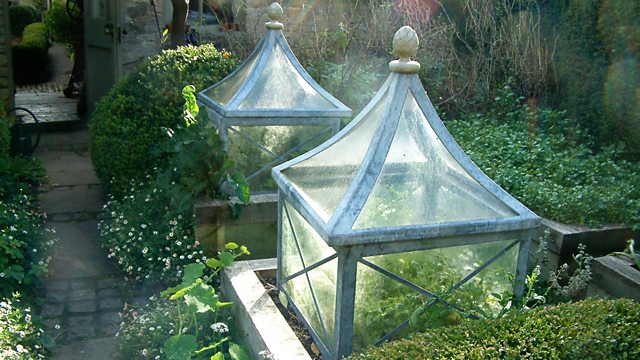Correspondence at Sparsholt
Eric Robson hosts as Matt Biggs, Bob Flowerdew, Anne Swithinbank and Rosie Yeomans tackle listeners' questions in the GQT potting shed at Sparsholt College.
Eric Robson hosts from the GQT potting shed at Sparsholt College as Matt Biggs, Anne Swithinbank, Bob Flowerdew and Rosie Yeomans tackle listeners' questions sent in by post, email and via Twitter.
Also in this episode, Pippa Greenwood provides top tips on how to get the best crops from your tomato plants next year and Matt Biggs visits Leicester University to hear about the latest research into the spread of Japanese Knotweed.
Produced by Darby Dorras
A Somethin' Else Production for 大象传媒 Radio 4.
Q. When is the best time of year to move a three to four-year-old fruit cage?
A. During the dormant period, any time between leaf fall and bud burst when the ground isn't waterlogged or frozen. The plants should move quite easily and be planted at the same level. Seaweed extract is a good tonic once they have settled in their new location. Make sure it is a weed-free site. If they are older than about four-years-old, propagation may be a better idea.
For blackcurrants, you would be better taking cuttings. But for strawberries, it is worth buying new plants instead.
Q. I have a north facing, 20x15ft (6mx1.8m) area of shaded garden inhabited by hens from May through to November. Is there anything that would grow between November and May that the hens would enjoy on their return?
A. Claytonia (Miner's Lettuce) disappears in the summer and reappears in the winter. Grass would encourage insects and worms for the chickens. Perhaps you could lay straw, giving the chickens something to scratch at. A Brassica planted early, such as a Spring Cabbage or Mustard, would also please the hens.
Q. Why would Giant Viper's Bugloss planted from seed not have flowered? Also, how should I treat them over the winter months?
A. They are very difficult to keep over the winter, as they don't like the damp. Protect the smaller ones by keeping them dry and in sunshine. They may have not flowered because they are monocarpic, meaning they grow until they are ready to flower and then die shortly afterwards. Flowering may have been delayed by last year's poor weather, but they will almost certainly flower next year.
Q. Do you have any suggestions for edibles to be grown on a cold, breezy allotment over winter?
A. It is unusual to have an exposed allotment, so perhaps invest in some windbreaks. Beetroot and Jerusalem Artichokes would work with cloches or collars of straw. Oriental vegetables, Chervil, Lamb's Lettuce, or Winter Kale could be grown under horticultural fleece. Leeks and Savoy Cabbage are very hardy and could work in an enriched soil.
Q. My first pickings from a crop of Gardeners' Delight tomatoes were tasteless and spongy. The trusses I picked later and left to ripen were much better. Would the fruit have been tastier if I had held back on watering so that the plant thought it was starving?
A. Over watering will reduce the taste of any fruit. Keeping plants slightly under stress can work. Make sure the compost is no more than slightly moist.
Q. Why would a healthy crop of grapes have turned colour before the fruit is ripe enough to eat?
A. The grapes will not be sweet because the season has been too short. Also, a heavy crop will mean that the plant cannot produce enough sugar. Always thin the crop, removing half of the fruit so that the remainder can grow bigger and sweeter. This year, you could make wine or dry the grapes to make raisins.
Q. How should recently planted Amazonian Lilies (Eucharis grandiflora) bulbs be kept throughout the winter?
A. The bulbs should be planted in the spring. During the winter treat them like a houseplant, keeping them in a conservatory or a bright position in the house. The temperature shouldn't be too high: protect them from the frost but keep the growth process at a slow rate.
Q. Could the lack of flowers on an Agapanthus be due to overcrowding?
A. Yes, it could be. There will be nowhere for the root growth to go. You should divide and repot them. However, the root growth is very tough and can be hard to remove from the pot. Perhaps run a knife around the edge, soak the soil, or even use a little detergent.
Last on
More episodes
Previous
Broadcasts
- Fri 8 Nov 2013 15:00大象传媒 Radio 4
- Sun 10 Nov 2013 14:00大象传媒 Radio 4
Six of GQT鈥檚 naughtiest gardening innuendos
When Gardeners' Question Time got mucky.
Podcast
-
![]()
Gardeners' Question Time
Horticultural programme featuring a group of gardening experts


